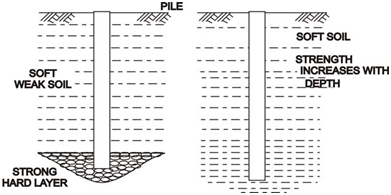Pile Foundations
If the soil in the top layers near the ground does not have adequate bearing capacity it would be essential to transfer the load to the lower strata. For buildings, this is achieved through means of piles.
Piles are long column-like members that transmit load of the structure by a weak material to underlying hard strata. If the bearing stratum is tough and impenetrable such as rock or hard dense gravel, a pile derives its strength majorly through bearing and is called as end bearing pile as display in Figure (a).

(a) End Bearing Pile (b) Friction Pile
Figure: Different Types of Piles (Based on Mode of Load Transfer)
Piles driven in soil that increasingly becomes stiff along with depth derive their bearing capacity from the friction along the surface of the pile and are called as friction piles as shown in Figure 14(b). Generally, in a pile, part of the load is carried through friction and part through end bearing.
Sheet piles are utilized as retaining structures and bulk heads.
Uplift piles or Tension are used to resist uplift forces because of hydrostatic pressure or overturning moment because of horizontal forces.
Compaction piles are used to compact granular soils to raise their bearing capacity. They are not generally needed to carry any load.
Piles could also be used to resist uplift pressures on structures as also to withstand lateral forces. Such piles are known as anchor piles.
Anchor piles are used to give anchorage against horizontal pull in a sheet pile. A pile that is installed at an angle to the vertical is called as a batter or raker pile.
Fender piles are utilized to protect water front structures beside impact from ships.